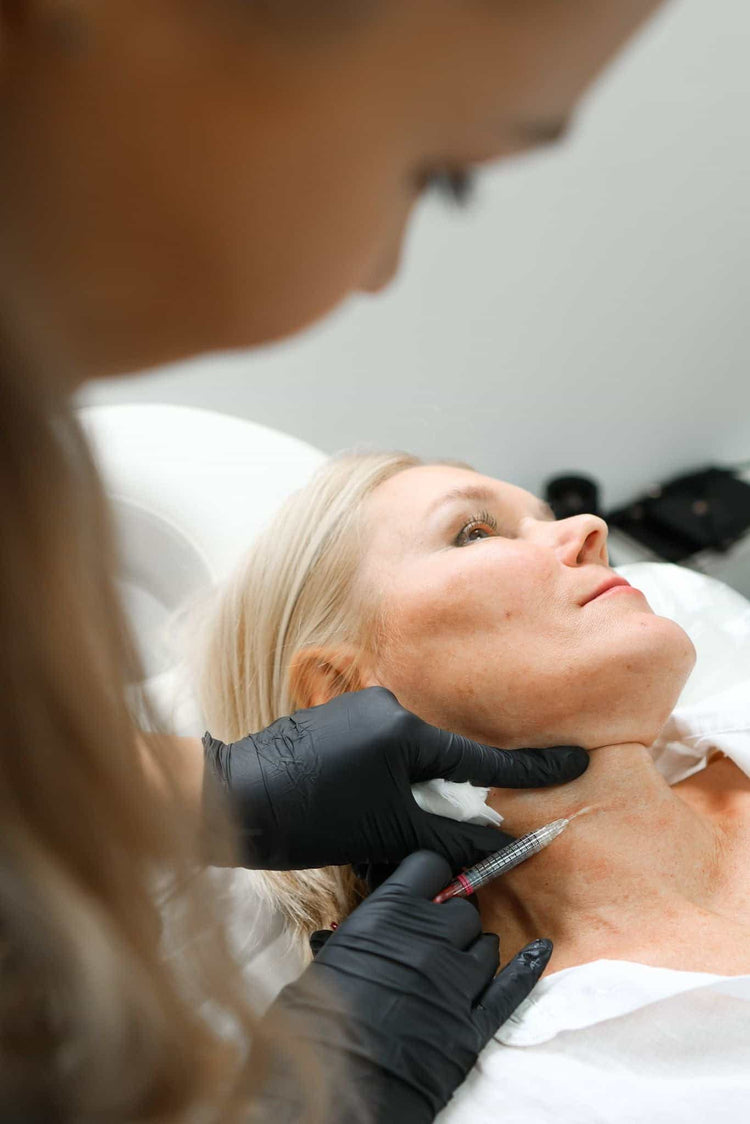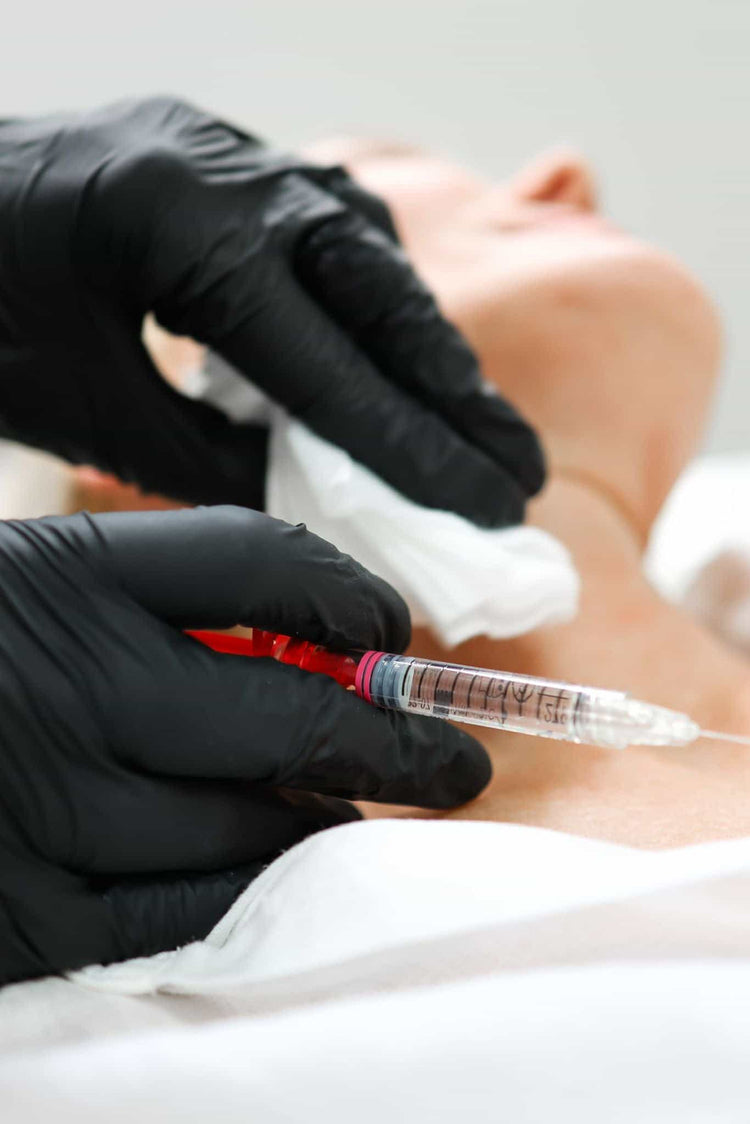Choosing the Right Practitioner

Finding the right practitioner for any cosmetic procedure is crucial, and when it comes to dermal fillers like those used for addressing neck lines, the choice becomes even more important. Overfilled results can have a dramatic and undesirable impact, creating a stiff, unnatural appearance. Understanding how to select a qualified and experienced professional who specializes in this area is essential for achieving a natural-looking and satisfying outcome.
Experience and Expertise
Experience and expertise are paramount when seeking neck line filler treatment. Look for practitioners with extensive experience specifically in dermal fillers, particularly those focused on the delicate area of the neck. Inquire about their training, qualifications, and any specialized certifications they hold in facial aesthetics.
Ask to see before-and-after photos of previous patients who have undergone neck line filler treatments, paying close attention to the naturalness and subtlety of the results. A good practitioner will prioritize your individual anatomy and desired outcome, tailoring the treatment plan accordingly. Don’t hesitate to ask questions about their approach, techniques, and the types of fillers they use.
Reputation and Reviews
Reputation and reviews offer valuable insights into a practitioner’s skill and patient satisfaction. Seek out online reviews on platforms like Google, Yelp, or specialized aesthetic review sites.
Pay attention to both positive and negative feedback, looking for patterns in comments about the practitioner’s communication, professionalism, and the quality of their work. Remember that individual experiences can vary, so consider a range of reviews to get a balanced perspective.
Consultation Process

The consultation process should provide you with a clear understanding of the treatment process, potential risks and benefits, and expected outcomes. A qualified practitioner will listen carefully to your concerns and goals, thoroughly examine your neck area, and discuss various options tailored to your individual needs.
Don’t hesitate to ask about the type of filler used, the amount injected, and the expected duration of results. It’s also essential to inquire about aftercare instructions and any potential side effects you might experience. A reputable practitioner will be transparent and answer all your questions patiently.
Understanding Filler Types and Volumes
Understanding the different types of dermal fillers and their varying volumes is crucial for achieving natural-looking results, especially when addressing neck lines. Each filler has unique properties that determine its suitability for specific areas and desired outcomes. Consulting with an experienced practitioner allows you to explore the options available and choose the filler best suited to your individual needs and goals.
Hyaluronic Acid Fillers
Hyaluronic acid (HA) is a naturally occurring substance in the body that helps retain moisture and provide volume to skin. It’s a common ingredient in dermal fillers used for addressing neck lines.
HA fillers come in various viscosities, ranging from light to very heavy. Lighter HA fillers are often preferred for treating fine lines and wrinkles around the mouth and eyes, while heavier HA fillers are better suited for volumizing larger areas like the cheeks or jawline.
When it comes to neck lines, a skilled practitioner will consider the severity of the wrinkles, your skin type, and desired outcome when choosing the appropriate HA filler and volume.
Volume Considerations
Understanding the different types of dermal fillers and their varying volumes is crucial for achieving natural-looking results, especially when addressing neck lines. Each filler has unique properties that determine its suitability for specific areas and desired outcomes. Consulting with an experienced practitioner allows you to explore the options available and choose the filler best suited to your individual needs and goals.
Hyaluronic acid (HA) is a naturally occurring substance in the body that helps retain moisture and provide volume to skin. It’s a common ingredient in dermal fillers used for addressing neck lines.
HA fillers come in various viscosities, ranging from light to very heavy. Lighter HA fillers are often preferred for treating fine lines and wrinkles around the mouth and eyes, while heavier HA fillers are better suited for volumizing larger areas like the cheeks or jawline.
When it comes to neck lines, a skilled practitioner will consider the severity of the wrinkles, your skin type, and desired outcome when choosing the appropriate HA filler and volume.
Communication is Key
Communication is key when undergoing any cosmetic procedure, but it’s especially crucial when considering neck line fillers in London. Open and honest dialogue with a qualified practitioner is essential for ensuring you achieve natural-looking results and avoid overfilled appearances.
Discussing Your Goals
Clear communication with your practitioner is essential to achieving the desired outcome. Be upfront about your goals, whether it’s smoothing fine lines, enhancing your jawline definition, or addressing deeper wrinkles. Share any concerns or anxieties you may have regarding the procedure and potential side effects.
Don’t hesitate to ask questions throughout the consultation process to gain a thorough understanding of the treatment plan. This includes inquiring about the type of filler used, the amount to be injected, the expected duration of results, and any potential risks involved.
Express your preferences regarding the level of correction you desire, emphasizing that you’re aiming for a natural-looking result rather than an overly exaggerated appearance.
Realistic Expectations
Communication is key when undergoing any cosmetic procedure, but it’s especially crucial when considering neck line fillers in London. Open and honest dialogue with a qualified practitioner is essential for ensuring you achieve natural-looking results and avoid overfilled appearances.
Clear communication with your practitioner is essential to achieving the desired outcome. Be upfront about your goals, whether it’s smoothing fine lines, enhancing your jawline definition, or addressing deeper wrinkles. Share any concerns or anxieties you may have regarding the procedure and potential side effects.
- Don’t hesitate to ask questions throughout the consultation process to gain a thorough understanding of the treatment plan.
- This includes inquiring about the type of filler used, the amount to be injected, the expected duration of results, and any potential risks involved.
- Express your preferences regarding the level of correction you desire, emphasizing that you’re aiming for a natural-looking result rather than an overly exaggerated appearance.
Aftercare Instructions
Aftercare instructions are crucial for ensuring optimal healing and achieving the desired results from your neck line filler treatment. Following your practitioner’s recommendations carefully will minimize any potential complications and help you maintain a natural-looking outcome.
Minimizing Swelling and Bruising
Aftercare instructions are crucial for ensuring optimal healing and achieving the desired results from your neck line filler treatment. Following your practitioner’s recommendations carefully will minimize any potential complications and help you maintain a natural-looking outcome.
- Avoid touching or massaging the treated area for at least 24 hours after the procedure to prevent displacement of the filler.
- Apply cold compresses to the area for the first few days following treatment to reduce swelling and bruising.
- Keep your head elevated while sleeping to minimize fluid buildup in the neck area.
- Avoid strenuous activities or exercise for at least a week after treatment.
- Stay hydrated by drinking plenty of water to help the body flush out any excess fluids and promote healing.
- Protect your skin from sun exposure by wearing sunscreen daily, as UV rays can degrade hyaluronic acid fillers over time.
Minimizing swelling and bruising after neck line filler treatment is essential for achieving a natural-looking outcome. Following these tips will help minimize any discomfort and ensure a smooth recovery:
- Apply cold compresses to the area immediately after treatment and periodically throughout the first few days.
- Elevate your head while sleeping for several nights following the procedure.
- Avoid alcohol consumption, as it can increase blood flow and exacerbate swelling.
- Eat a healthy diet rich in antioxidants and vitamins to promote healing.
Protection from Sun Exposure
Protecting your skin from sun exposure is crucial after any cosmetic procedure, including neck line filler treatment. UV rays can degrade hyaluronic acid fillers over time, leading to premature loss of volume and an unnatural appearance.
To ensure the longevity of your results and maintain a natural-looking outcome, follow these sun protection tips:
- Wear sunscreen daily, even on cloudy days, with an SPF of 30 or higher.
- Reapply sunscreen every two hours, especially if you are sweating or swimming.
- Seek shade whenever possible, particularly during peak sun hours (10 am to 4 pm).
- Wear protective clothing, such as a wide-brimmed hat and sunglasses, to shield your neck from direct sun exposure.
Follow-Up Appointments
Aftercare instructions are crucial for ensuring optimal healing and achieving the desired results from your neck line filler treatment. Following your practitioner’s recommendations carefully will minimize any potential complications and help you maintain a natural-looking outcome.
Aftercare instructions are crucial for ensuring optimal healing and achieving the desired results from your neck line filler treatment. Following your practitioner’s recommendations carefully will minimize any potential complications and help you maintain a natural-looking outcome.
- Avoid touching or massaging the treated area for at least 24 hours after the procedure to prevent displacement of the filler.
- Apply cold compresses to the area for the first few days following treatment to reduce swelling and bruising.
- Keep your head elevated while sleeping to minimize fluid buildup in the neck area.
- Avoid strenuous activities or exercise for at least a week after treatment.
- Stay hydrated by drinking plenty of water to help the body flush out any excess fluids and promote healing.
- Protect your skin from sun exposure by wearing sunscreen daily, as UV rays can degrade hyaluronic acid fillers over time.
Minimizing swelling and bruising after neck line filler treatment is essential for achieving a natural-looking outcome. Following these tips will help minimize any discomfort and ensure a smooth recovery:
- Apply cold compresses to the area immediately after treatment and periodically throughout the first few days.
- Elevate your head while sleeping for several nights following the procedure.
- Avoid alcohol consumption, as it can increase blood flow and exacerbate swelling.
- Eat a healthy diet rich in antioxidants and vitamins to promote healing.
Protecting your skin from sun exposure is crucial after any cosmetic procedure, including neck line filler treatment. UV rays can degrade hyaluronic acid fillers over time, leading to premature loss of volume and an unnatural appearance.
To ensure the longevity of your results and maintain a natural-looking outcome, follow these sun protection tips:
- Wear sunscreen daily, even on cloudy days, with an SPF of 30 or higher.
- Reapply sunscreen every two hours, especially if you are sweating or swimming.
- Seek shade whenever possible, particularly during peak sun hours (10 am to 4 pm).
- Wear protective clothing, such as a wide-brimmed hat and sunglasses, to shield your neck from direct sun exposure.
Follow-up appointments are an essential part of ensuring optimal results from your neck line filler treatment. These appointments allow your practitioner to monitor your progress, assess the placement and longevity of the filler, and address any concerns or questions you may have.
- Your practitioner will likely schedule a follow-up appointment within a few days after your initial treatment to check on your healing progress, review any potential side effects, and ensure the filler has settled into place correctly.
- Depending on the type of filler used and individual factors, you may have additional follow-up appointments scheduled at intervals of several weeks or months to maintain optimal results.
- How To Avoid Overfilled Results With Neck Line Fillers In London - August 28, 2025
- How Safe Is Obagi Nu-Derm System In Kingston Upon Thames Surrey London - August 21, 2025
- How Much Do Fillers Cost In The UK? - August 12, 2025
